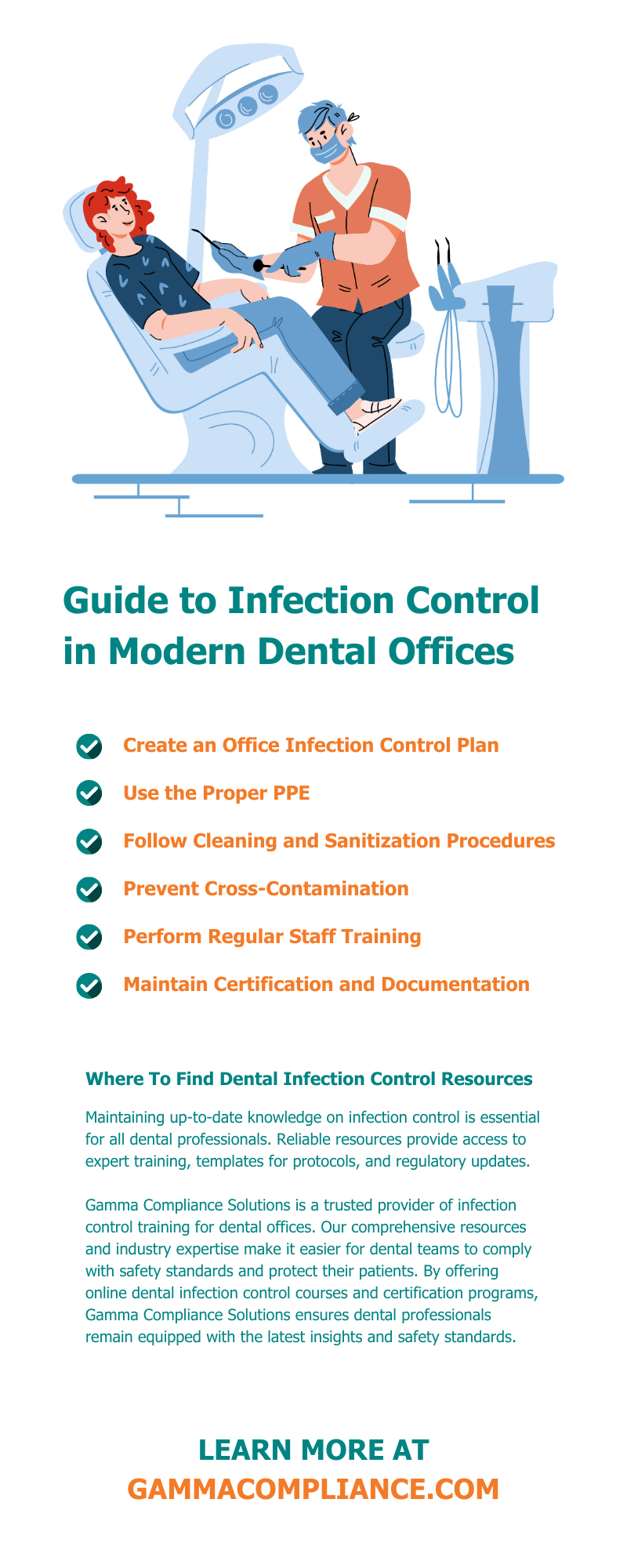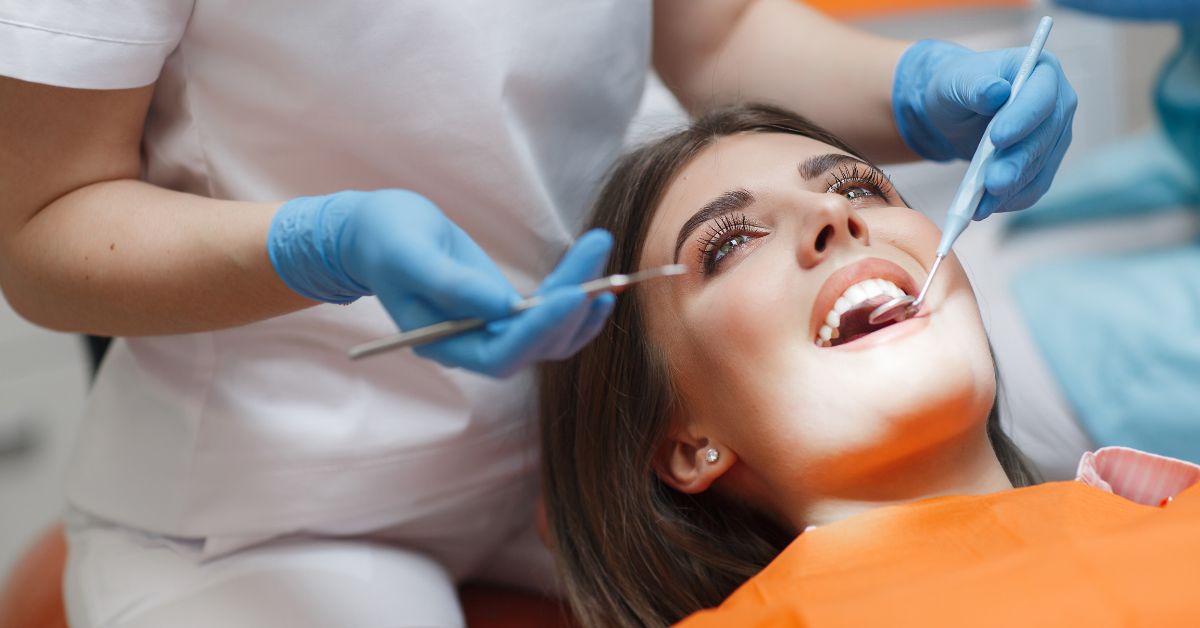Protecting patient and professional health is a primary focus in any dental practice to ensure safety and quality care. Modern guidelines such as those from the Centers for Disease Control and Prevention (CDC) are key to infection control by preventing the spread of infectious diseases.
By adopting and strictly adhering to these infection control measures, dental professionals can enhance safety and build trust and maintain confidence in their practice, fostering a secure environment for both staff and patients. This is a comprehensive guide to implementing infection control in modern dental offices.
Understanding Infection Control
Infection control encompasses all procedures designed to prevent or reduce the spread of pathogens. Given the unique challenges that dental settings present—such as direct exposure to saliva and blood—it is vital to adhere to specialized infection control practices. Effective infection control mitigates risks for patients, staff, and the broader community while ensuring compliance with legal and ethical obligations.
Guidelines for infection control evolve based on emerging research and public health recommendations, making it crucial for dental professionals to stay informed. Adopting a proactive approach to infection control safeguards those who visit the office as well as the practice’s longevity and reputation.
How To Maintain Dental Office Infection Control
Maintaining rigorous infection control protocols in a dental office protects the safety of patients and staff alike. By incorporating evidence-based practices and following established guidelines, dental professionals can create a clean, hygienic environment that minimizes the risk of disease transmission. The following tips provide actionable steps to uphold the highest standards of infection prevention in your practice.
Create an Office Infection Control Plan
An infection control plan is the foundation of a safe dental environment. This plan provides clear protocols for addressing contamination risks during daily operations. Start by assessing potential hazards within the office, such as instrument sterilization, patient interactions, and waste disposal. Once you have identified these risks, establish detailed procedures and assign specific responsibilities to staff.
Protocol templates from health organizations, such as the Centers for Disease Control and Prevention (CDC), can serve as valuable resources to develop or refine your plan. Regularly review and revise the plan to ensure it aligns with infection control standard updates.
Use the Proper PPE
Personal protective equipment (PPE) helps ensure the safety of healthcare workers and patients. High-quality PPE, including gloves, masks, protective eyewear, and gowns, provides a physical barrier against pathogens, reducing the risk of cross-contamination and infection. Choosing the correct type of PPE for each procedure assists in maintaining a safe working environment and achieving optimal protection.
To maximize protection, inspect all PPE for any damage before each use. Look for damage such as tears or punctures that could allow pathogens through.
Properly fitted PPE is equally important—ill-fitting gloves or loose masks can compromise safety and effectiveness. Providing staff with adequate PPE training helps them understand when to use different types of PPE and how to put them on (donning) and take them off (doffing) without contaminating themselves or the environment.
Additionally, establish clear protocols for safe single-use PPE disposal, such as gloves, masks, and gowns, to prevent pathogen spread. For reusable items like eyewear or gowns, establish strict cleaning and disinfection procedures to ensure they remain safe and effective for future use. By prioritizing proper usage, maintenance, and PPE disposal, organizations can significantly minimize infection risks and create a safer workplace for everyone involved.
Follow Cleaning and Sanitization Procedures
Rigorous cleaning and sanitization reduce microbial contamination on surfaces and equipment. Dental settings require standard cleaning and advanced disinfection measures, especially in high-contact areas such as dental chairs, countertops, and doorknobs.
Use disinfectants approved by the Environmental Protection Agency (EPA) and CDC and apply them at recommended concentrations and contact times. Equip your team with the tools and training necessary to properly clean instruments and maintain sterilization equipment like autoclaves. Implementing a schedule for regular cleaning promotes consistency and accountability for keeping your dental office clean and sterilized.
Prevent Cross-Contamination
Cross-contamination occurs when pathogens spread between surfaces, instruments, and individuals within the dental office. Preventing this requires stringent sterilization, appropriate instrument storage, and procedural discipline. For instance, never reuse single-use instruments.
Practices such as hand hygiene serve as the first line of defense against cross-contamination. Staff should wash their hands thoroughly with soap and water or use alcohol-based hand sanitizers before and after every procedure. Establishing clear workflows can also minimize unnecessary contact between sterile and non-sterile areas.
Perform Regular Staff Training
Well-informed staff make infection control protocols more effective. Regular training helps every team member understand the importance of infection control and their specific role in implementing these measures. Training sessions should cover topics such as updated cleaning protocols, PPE usage, and emergency response plans for exposure incidents.
Tailor training to your office’s specific needs and conditions, addressing gaps in knowledge or compliance. By empowering staff with knowledge and resources, dental professionals can ensure consistent adherence to infection control standards.
Maintain Certification and Documentation
Compliance with infection control guidelines often requires maintaining proper documentation and certifications. Regulatory bodies may mandate regular assessments or audits, which require accurate documentation.
Key documentation includes sterilization logs, maintenance records for sterilization equipment, and staff training certifications. Stay updated with local, state, and federal requirements to avoid noncompliance fines or penalties.
Common Challenges and Solutions to Maintaining Infection Control
Dental offices often face several challenges in maintaining effective infection control practices. Limited budgets can restrict access to advanced equipment or training programs. Staff turnover may result in inconsistent adherence to protocols. Additionally, staying current with frequently updating regulations can be challenging.
To address these challenges, prioritize investments in essential infection control measures, such as PPE and sterilization equipment. Develop a standardized onboarding process to keep new staff aligned with office protocols. Leverage online resources and tools, such as those offered by Gamma Compliance Solutions, for access to training and regulation updates.
Where To Find Dental Infection Control Resources
Maintaining up-to-date knowledge on infection control is essential for all dental professionals. Reliable resources provide access to expert training, templates for protocols, and regulatory updates.
Gamma Compliance Solutions is a trusted provider of infection control training for dental offices. Our comprehensive resources and industry expertise make it easier for dental teams to comply with safety standards and protect their patients. By offering online dental infection control courses and certification programs, Gamma Compliance Solutions ensures dental professionals remain equipped with the latest insights and safety standards.
Safeguard Your Patients and Practice Today
Upholding infection control standards is a collective effort that demands vigilance, dedication, and access to the right resources. From creating comprehensive infection control plans to performing regular staff training, each component contributes to a safer dental environment. Use this guide to infection control and implement each of these strategies for a reputable and professional modern dental office.
Adhering to infection control protocols has immediate health and safety benefits and builds long-term trust with your patient base. Explore top-notch training programs and resources through Gamma Compliance Solutions to strengthen your practice’s commitment to infection control today.



